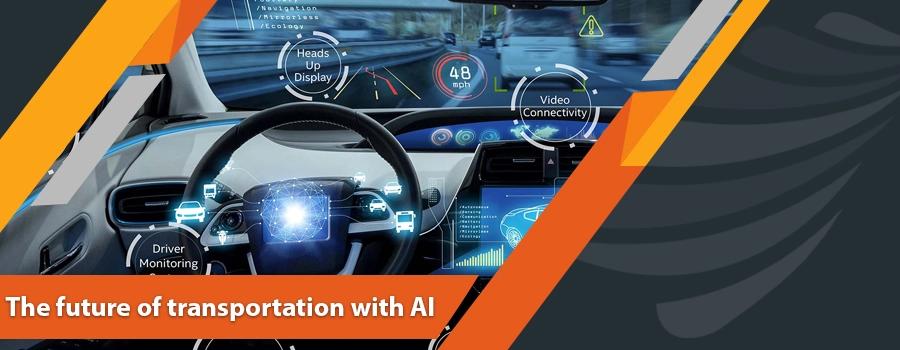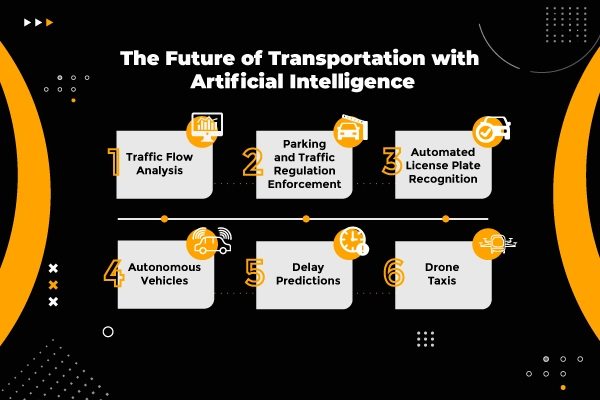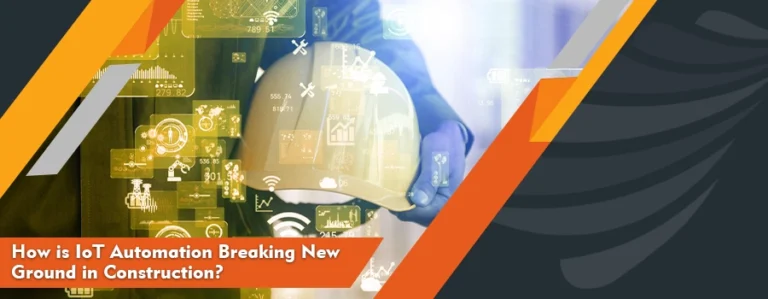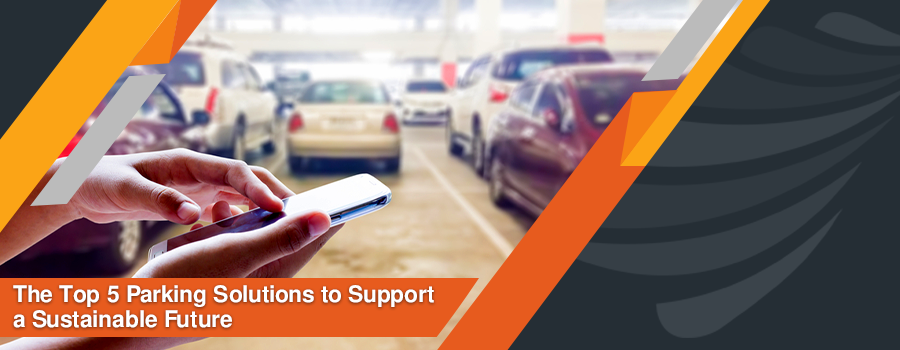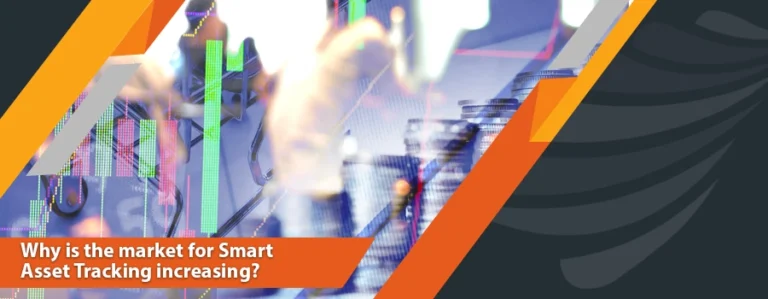Over the last few decades, the transportation industry has undergone several changes for making transport secure, comfortable and fast for the public. Now, the industry is on the edge of breakthroughs that will be achieved with the help of Artificial Intelligence (AI). The applications of AI in transportation are revolutionary and have the potential to ease traffic congestion, traffic management and smooth parking experience etc. This can ultimately reduce vehicle fuel consumption along with improving urban planning and air quality. By 2023, it is expected that the global market of AI in transportation will reach 3.5 billion dollars. This indicates that the future of transportation, encapsulated by AI has both financial and non-financial benefits. Smart transport will become smarter in the future and the following AI-based applications will determine how the transport industry can unlock future opportunities
1. Traffic Flow Analysis
With the increased number of vehicles on the roads, the traffic congestion has also increased dramatically. The congestion costs time and money, stressing the drivers and contributing to global warming. With better traffic flow, road safety can be improved immeasurably. With the help of computer vision and machine learning algorithms, AI is paving the way for smooth traffic. Data is collected through cameras and drones allocated to different congestion points in cities for traffic flow analysis. Later on, the data is fed into AI-enabled smart systems which can easily count and track freeways with accuracy along with traffic density. This helps the municipalities to monitor traffic flow conditions in the cities so that they can design more efficient traffic management systems with improved road safety. Furthermore, AI in combination with data processing will provide important details like road blockages, accidents and traffic predictions along with notifying the people of the shortest route to their destination. AI has the potential to eliminate unwanted traffic on the road and improve safety.
2. Parking and Traffic Regulation Enforcement
Parking and traffic regulation enforcement have become easier with the help of AI. Cameras and a wide range of IoT sensors are used to collect data. For instance, the sensor can detect the occupancy status of the parking spots which help the drivers in finding the parking spots in the congested city immediately. Furthermore, with the camera-based AI system, the patrolling officers can detect vehicles that are violating traffic laws. For instance, AI systems detect the speed of the vehicles passing on the road and can generate alerts if any of the vehicles is over speeding. This will help the officers in identifying the vehicles along with their number plate, car model type and colour to charge them for traffic violations. These systems have been deployed by many countries but complete adoption of AI-enabled traffic monitoring systems are still in progress. Ultimately, the future of transportation with AI will be effortless.
3. Automated License Plate Recognition
Automated license plate recognition (ALPR) incorporates computer vision-based camera systems attached to street poles, overpasses and highways to capture the license plate, time, date and location of the vehicle. This highly advanced system with AI features is extremely handy for police officers in crime detection and prevention. For instance, police can determine the presence of a specific vehicle at the crime scene. In the future, the same technology will be used to detect travel patterns, toll management, and parking management and help car dealership companies to keep track of their assets. This can prevent the cars to be used in illegal activities.
4. Autonomous Vehicles
The key application of Artificial Intelligence in transportation that has become increasingly famous is the advent of autonomous vehicles. Autonomous vehicles are nothing but self-driving cars which incorporate a wide range of sensors, such as LiDAR, RADAR and cameras etc. to understand the surroundings and take action on the path planning accordingly. The IoT-based sensors generate an enormous amount of data, which is then translated into useful insight with the help of AI algorithms, object character recognition, machine learning and computer vision techniques. Slowly and gradually, the concept of the autonomous vehicle is becoming a practical reality from a sci-fi future. Apart from the vehicles, autonomous trucks and taxis have also made their entries into the transportation industry. For instance, the tech-savvy nation, Tokyo has already started using autonomous taxis for public transportation. Whereas, in the US, by using autonomous trucks for goods transport, the nation has accessed many benefits. As per the report published by McKinsey, autonomous trucks can reduce administrative and maintenance costs by 45%. The use of AI-powered autonomous vehicles has not become a norm right now, but it will be soon.
5. Delay Predictions
The future of transportation with AI is not only limited to vehicles or traffic management as AI is also revolutionizing the aviation sector and solving the traditional problems with innovation in this regard. In air transport, the most burning problem is related to flight delays. This not only gives rise to financial losses but also impact the customer’s flying experience adversely. The negative experience also harms the transport company’s reputation and enhance the customer churn rate. To overcome this issue in the future, AI has come to the rescue. By using computer vision and data lake technology, the aviation industry can enhance the customer journey experience by cutting down wait time and offering exceptional services. Anything from a technical glitch to bad weather can impact the flight timings, however, with the help of AI, aviation companies will be able to track the delays in real-time and inform the passenger beforehand. Furthermore, machine learning and AI will process real-time weather information, historical record and airplane data to track the hidden patterns that might cause flight cancellations and delays.
6. Drone Taxis
One of the most innovative and exciting future AI applications in transportation is the introduction of drone taxis. To eliminate costly infrastructure planning, traffic congestion and combat carbon emission, the concept of pilotless helicopters seems a unique and viable solution. Also, with the help of drone taxis, the passengers will be able to reach their destination as soon as possible. Furthermore, the increasing population have pressurized the municipalities to ensure smart urban planning without making any compromise over the declining resources. In this regard, AI-based drone taxis are the real solution to all the problems faced by city planners. Recently in China, nearly 17 passengers experienced smart air mobility with the help of autonomous aerial vehicles. This indicates the positive adoption of similar AI applications in the future to ease mobility. Besides, many delivery companies have also started using drones for delivery services. AI assist drone deliveries with GPS navigation, obstacle detection and avoidance, delivery drop, emergency and contingency management. This normalization of drone deliveries will help companies to scale up their delivery operations.
Conclusion
AI is undoubtedly the most amazing innovation of humankind, however, with every amazing invention to ease the life of human beings it can be observed that until now, AI has not been utilized to its full potential and a lot of things need to be explored further. The application of AI in transportation mentioned in this article just provides a glimpse of opportunities and possibilities that technology can offer to the future of transportation. The future of transport driven by AI will be exciting and will be focused on solving the traditional transportation problems.

